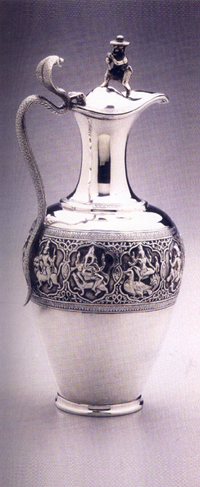|
Did you know that Swami Silver was the name given during the British Raj to silverware from Madras and Bangalore that featured Hindu Gods and Goddesses? And that our own P. Orr & Sons was a pioneer in this area? These and other facts I learnt from Vidya Dahejia, an America-based expert in Indian art, recently.
 |
Madras calling card cases were famous even in the early 19th Century and these featured a god or two on the top, thereby getting the name “Swami cases”. But the Georgian style featuring straight sides and less ornamentation popularised by Hamilton & Co of Calcutta was preferred over Swami patterns. However, the Great Empire Exhibition of 1851 at the Crystal Palace in London, the brainchild of Prince Albert, opened the eyes of the public to the beauty of Indian silver and soon Indian patterns were in demand for curry pots and marrow spoons. In Madras, Gordon & Co and, later, Peter Orr cashed in on this demand. The latter firm, later to become famous as P. Orr & Sons, experimented with silver claret jugs that were plain all around except for a single band of Swami work around the neck. The results must have been encouraging, for P. Orr soon branched into silverware that featured elaborate Swami work. There was the famous Madras Swami Tea Service. There were trays depicting the ten incarnations of Vishnu, sugar pots that had the child Krishna crawling out by way of handles, spoons that featured Nayak style animals on the handles, and even whistles for syces.
The Prince of Wales’ visit to India in 1876 was yet another reason for Swami Silver to become popular. Maharajahs vied with one another to present the Prince with gifts and placed large orders on P. Orr. The Gaekwad of Baroda and the Maharajah of Indore both gave P. Orr tea services that featured Swami work to the Prince. The Maharajah of Cochin gave a dessert service. Soon, a line of Swami jewellery also began doing the rounds.
It was not long before competition began catching up with P. Orr. The first in line was Krishnaiah Chetty & Sons of Bangalore. That firm did Swami work too. The most successful among the competitors was Omarsi Maoji of Kutch who too began Swami work and first experimented with a claret jug. The firm slowly gave a new meaning to Swami work by featuring fewer Gods and more animals and birds. Drawings used by the silversmiths of Omarsi Maoji have survived and these bear appreciative remarks by some buyers as well. Kutch work was highly prized and, soon, London shops began placing orders for silverware to cater to Yuletide demand. Not long afterwards other centres, such as Kashmir (known for paisley designs), Alwar (for very delicate work), Calcutta (largely depicting rural scenes), and Bombay (urban scenes), began developing. Burma had its own silver styles too. These depicted scenes from the Jataka tales.
Ravi Varma was the source of inspiration from 1884 onwards when his oleographic press began churning out prints of his art works. P. Orr produced silver articles such as tea caddies, milk jugs and tea pots, with the Ravi Varma painting of Saraswathi depicted on them. Swami silver had come full circle. From brass and stone icons for inspiration, it had moved to paintings and prints which people of Madras preserve and worship even today. Dahejia, however, says that there is no trace of the Madras Swami Tea Service presented to the Prince of Wales. Her researches have led her to the conclusion that the tea service may have made its way to one of the provincial museums of England and is perhaps awaiting rediscovery.
|